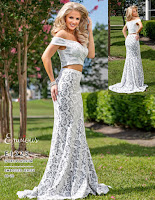The train has long been a feature of bridal gowns, but other formal dresses also are enhanced with mostly shorter trains.
The History of Bridal Gown Trains
Bridal gown trains date back to the Middle Ages when the length of a train reflected rank within the court of royalty. A bride could prove she was worthy to marry into another royal family if her family could afford the yards and yards of expensive fabric that went into creating the train. Queen Victoria is credited with starting the tradition of having her bridesmaids carry her train into the cathedral.Naturally, these styles found appeal among the non-royal classes and the wedding dress train became a tradition throughout western society. During the 20th century, trains fell out of favor as brides sought to show only the latest fashions, but they have returned to prominence again as brides strive to reflect traditional values.
The train and its length set the tone for the formality of the wedding, as well.
Train Styles
Traditionally, the train is merely an extension of the hemline in the back of the dress. Again, the length will be determined by how formal you want your wedding to be. A brush or sweep train will extend only 6-12 inches onto the floor or you can opt for a cathedral style that will extend more than a yard onto the floor.You also have other options. A Watteau train is one that attaches at the shoulders. You also can consider a detachable train that fastens at the waistline, either in a belt style that can easily be unfastened or one that snaps or buttons across the back. These styles are considered slightly less formal.
Many other formal dresses also feature a train these days, typically more the brush style. The advantage with a formal dress is the sweeping look it provides, especially as you enter an event, letting you "announce" your presence.
What to Do with the Train
Once you've decided on a train, you'll also be concerned about how you are going to navigate through your evening with all that extra fabric.A wedding gown often will feature a bustle, whereby you gather up the train and attach it to the back of the dress, creating a beautiful look with the extra fabric.
With a smaller train and a simpler fabric, you can add a loop to the train that you can hook to your wrist or finger so you can carry the extra fabric and not have to worry about others stepping on it.
Of course, if you opted for a detachable train, you simply detach it and put it in a safe place.
If dealing with a train seems like too much of a hassle, your best options are to choose a dress with no train or pay your seamstress to cut off the train while hemming the dress.





This comment has been removed by a blog administrator.
ReplyDeleteThis comment has been removed by a blog administrator.
ReplyDeleteThis comment has been removed by a blog administrator.
ReplyDeleteThis comment has been removed by a blog administrator.
ReplyDeleteThis comment has been removed by a blog administrator.
ReplyDeleteThis comment has been removed by a blog administrator.
ReplyDeleteThis comment has been removed by a blog administrator.
ReplyDelete